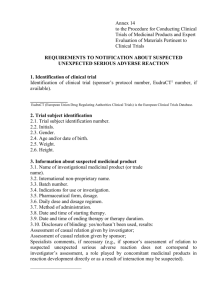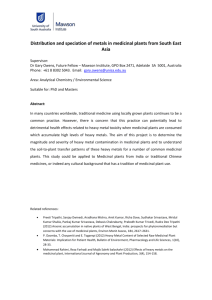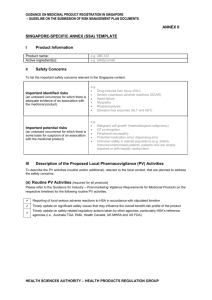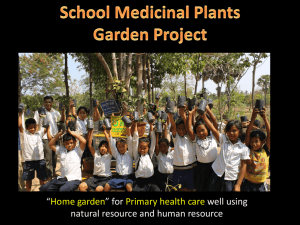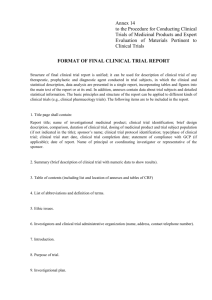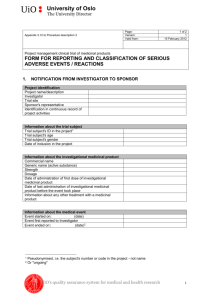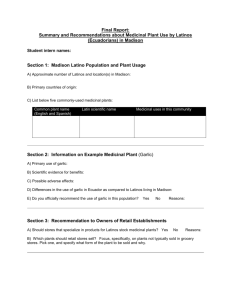4_AV
advertisement
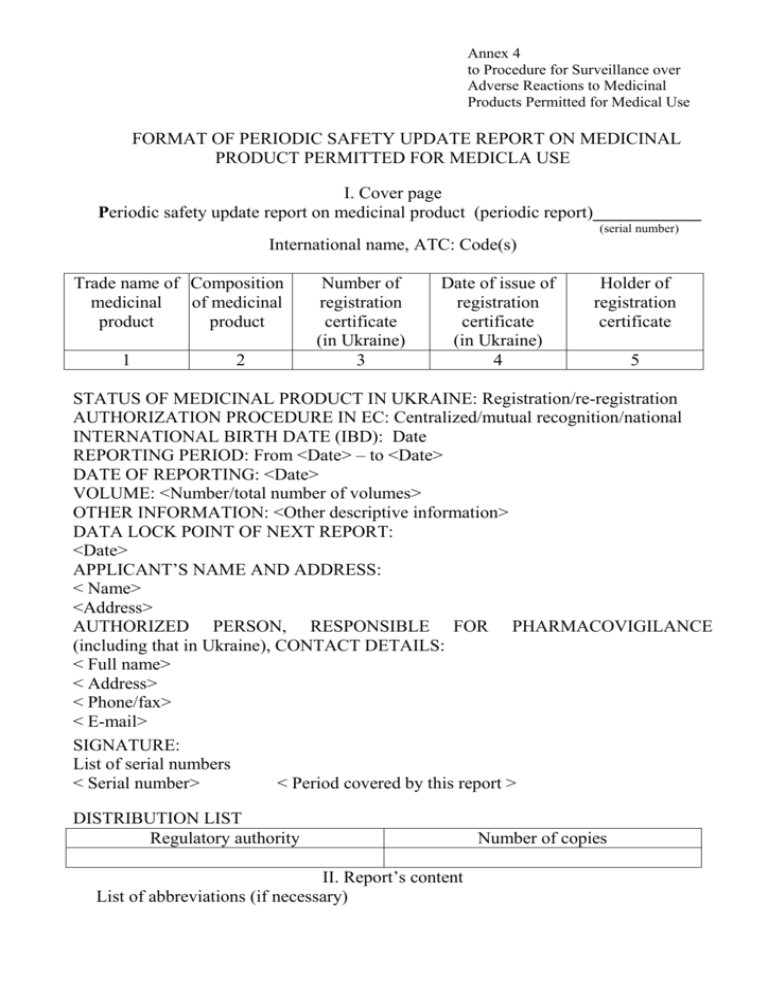
Annex 4 to Procedure for Surveillance over Adverse Reactions to Medicinal Products Permitted for Medical Use FORMAT OF PERIODIC SAFETY UPDATE REPORT ON MEDICINAL PRODUCT PERMITTED FOR MEDICLA USE І. Cover page Periodic safety update report on medicinal product (periodic report)____________ (serial number) International name, АТС: Code(s) Trade name of Composition medicinal of medicinal product product 1 2 Number of registration certificate (in Ukraine) 3 Date of issue of registration certificate (in Ukraine) 4 Holder of registration certificate 5 STATUS OF MEDICINAL PRODUCT IN UKRAINE: Registration/re-registration AUTHORIZATION PROCEDURE IN EС: Centralized/mutual recognition/national INTERNATIONAL BIRTH DATE (IBD): Date REPORTING PERIOD: From <Date> – to <Date> DATE OF REPORTING: <Date> VOLUME: <Number/total number of volumes> OTHER INFORMATION: <Other descriptive information> DATA LOCK POINT OF NEXT REPORT: <Date> APPLICANT’S NAME AND ADDRESS: < Name> <Address> AUTHORIZED PERSON, RESPONSIBLE FOR PHARMACOVIGILANCE (including that in Ukraine), CONTACT DETAILS: < Full name> < Address> < Phone/fax> < E-mail> SIGNATURE: List of serial numbers < Serial number> < Period covered by this report > DISTRIBUTION LIST Regulatory authority ІІ. Report’s content List of abbreviations (if necessary) Number of copies 2 Annex 4, continued 1. Basic statements/explanatory note (a brief description of each safety report in the form of explanatory note which includes summary; licensing status in the world; important regulatory information (e.g., information about any urgent safety restrictions related to use of medicinal product); data about use, number of new reports received during reporting period, as well as summarized data). 2. Introduction. 3. World-wide market authorization status (table format: country, registration certificate’s number, date of issue of marketing authorization and subsequent reregistration; any restrictions of license conditions; indications for use; date of entering the market; trade name(s)). 4. Update of actions taken by regulatory authorities or registration certificate holder for safety reasons (marketing authorization withdrawal or suspension; rejection in re-registration; restrictions for use; change of dosage regimen; change of indications for use; formulation changes, etc. The safety-related reasons that caused the appropriate decision being taken should be indicated and the required documentation submitted; with copies of relevant reports). 5. Changes to reference safety information (the applicant may use list of applicant’s core data together with the applicant’s core safety data as reference safety information). The changes to applicant’s safety data related to contraindications, warnings and adverse reactions to medicinal product or due to its interaction with other medicinal products already made during reporting period should be clearly described with submission of the modified sections. When essential differences exist between the instructions for medical use and EC safety data of medicinal product (or official data sheets/product information document approved in Ukraine), a brief comment should be prepared by the applicant describing the present differences and their consequences to the overall safety evaluation and actions proposed or initiated. This comment shall be provided as a cover letter or addendum to the periodical report). 6. Patient exposure (an estimate of the number of patients exposed should be provided along with the method used to derive the estimate: patient-days, number of prescriptions or number of dosage units of medicinal product, etc. If these or other more precise measures are not available the bulk sales (packaging, presentation unit or tonnage) may be used. If the number of patients is impossible to estimate the appropriate explanations and justifications shall be presented. The estimation of patient exposure and estimation method used to derive the estimate (adverse reaction incidence during medical use of this medicinal product, etc.) should be presented. When data reported indicate a potential problem, details by countries (locally recommended daily dose) or other segmentations (e.g., indications, pharmaceutical forms) should be presented. 7. Presentation of individual case histories (description and analysis of cases which contain new and/or important safety information related to medicinal product. Such cases should be classified according to MedDRA terminology by System Organ Classes (SOC). The inclusion criteria used for analysis shall be described). 7.1. Cases of adverse reactions to medicinal product are to be presented as line listings. The line listings should include: а) all serious adverse reactions and non-serious unregistered adverse reactions received through spontaneous reporting; 3 Annex 4, continued b) all serious adverse reactions (which investigator or sponsor relates to the use of medicinal product), which have been received from safety or other studies (including those being a part of risk management plan) or programs for use of medicinal product in exceptional circumstances (use of product by specific patient); c) all serious adverse reactions and non-serious unregistered adverse reactions; d) all serious adverse reactions submitted to the applicant by the country regulatory authorities. All types of cases presented below should be annexed to the periodic report: а) all non-serious registered adverse reactions received through spontaneous reporting; b) all serious and non-serious registered adverse reactions reported by patients and other non-health workers (not proved by health worker/physician). The suspected transmission of any infectious agent during use of medicinal product shall be considered as serious adverse reaction. The line listings should include each patient only once, regardless of how many adverse reaction terms are reported for the case. If there is more than one reaction, they should all be mentioned but the case should be listed under the most serious ADR (symptom, diagnose) as judged by the applicant. Cases should be classified (summarized in table-list) according to MedDRA terminology by System Organ Classes (SOC). The list should include the following information: applicant’s case reference number; country, in which case occurred; source of report; patient’s age and sex; dosage regimen of suspected medicinal product; date of onset of adverse reaction; date of start and end of therapy (duration of treatment); description of reaction as reported; patient outcome (e.g., fatal, resolved, complicated); comment (causal effect assessment, if the applicant disagrees with the reporter; concomitant medications, suspected to play a role in the reaction development; indications for prescription of the given medicinal product; dechallenge/rechallenge results, etc. 7.2. Cases presented in summary tabulations (provide an aggregate summary for each case of adverse reaction to medicinal product in line listings where serious and non-serious reactions being registered or not registered are specified. When there is a lack of information for summary tabulation the data should be presented in optional form. If necessary, the summary tabulations may be sorted by source of information or by country of report). 7.3. Analysis of individual case histories by applicant (the comment to individual case histories shall be provided. Analysis of serious or unexpected adverse reactions shall be conducted – its character, medical significance, mechanism, incidence, etc.). 8. Studies (information about all studies (nonclinical, clinical, epidemiological, which contain safety data (including information about lack of efficacy) with possible effect to product information shall be provided; specially planned studies, those being conducted and published studies, where the safety issues are considered, should be included in discussion of any intermediate and final results. The studies which are a part of risk management plan shall be provided). 8.1. Newly analyzed studies (all studies containing important safety information and reanalyzed during the reporting period should be described including data from epidemiological, toxicological or laboratory investigations. Add copies of complete study reports which contain significant safety and efficacy results (if necessary). 4 Annex 4, continued 8.2. New target safety studies (planned, initiated or ongoing during the reporting period). 8.3. Published study data (notifications/reports in scientific and medical literature including appropriate published paper abstracts of workshops/conferences, which contain important safety results (positive or negative) with references to the appropriate publications). 8.4. Other studies (any important information about data obtained from registers of pregnant exposure and the comment on positive and negative experience of use of medicinal product during pregnancy shall be provided). 9. Other information. 9.1. Efficacy-related information (information about cases of lack of efficacy shall be provided). 9.2. Late-breaking information (any important new information received after data lock point shall be submitted for study and report. New data shall also be considered in “Overall safety evaluation” of periodic report). 9.3. Risk management plan (risk management plan shall be discussed if it exists; the efficacy of risk management system shall be evaluated). 9.4. Report on analysis of risk/benefit ratio (provide summary of analysis of risk/benefit ratio or safety analysis if such analysis had been conducted). 10. Overall safety evaluation. 10.1. The applicant should present a concise analysis of data along with assessment of significance of the data collected during this period. The collected data about adverse reactions should be analyzed and the following information should be presented: a) changes in characteristics of adverse reactions to medicinal product (severity, outcome, target population) registered by the applicant (specified in applicant’s core safety information); b) number of serious adverse reactions to medicinal product not registered by the applicant (not mentioned in applicant’s core safety information); c) number of non-serious adverse reactions to medicinal product not registered by the applicant (not mentioned in applicant’s core safety information); d) an increased occurrence of reported adverse reactions to medicinal product registered by the applicant (mentioned in applicant’s core safety information), including comments on whether the data are believed to reflect essential changes in adverse reaction frequency. 10.2. Information should explicitly address any new safety issue related to the use of medicinal product with comment and assessment of significance of such information regarding: а) drug interactions; b) experience with overdose (deliberate or accidental) and appropriate treatment; c) drug abuse, accidental or irrational use of medicinal product; d) experience of using medicinal product during pregnancy or lactation; e) experience of using medicinal product in special patient groups (children, elderly, organ and system impaired); f) effects of long-term treatment; g) reports from patients and other non-health workers (if necessary); h) if there are errors in prescription/treatment including errors with trade names or packaging of medicinal product which affect the safety of medicinal product. 5 Annex 4, continued 11. Conclusion: а) indicate safety data which do not comply with the previously obtained data and with the reference safety information about use of medicinal product; b) specify and justify any action recommended or initiated; c) make overall conclusion about safety of medicinal product at medical use during reporting period. When decision is taken about introduction of changes to instructions for medical use of medicinal product, the applicant should submit application on introduction of changes along with periodical report or if this is not possible present a schedule of submission of these documents. Note. If the periodic report has been submitted in English, sections 4, 5 and 11 shall be provided in Ukrainian or Russian. Section 10 of periodic report should be provided in Ukrainian or Russian, if requested by the Center.


